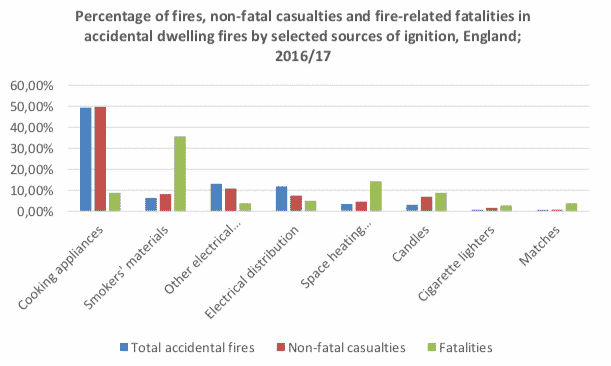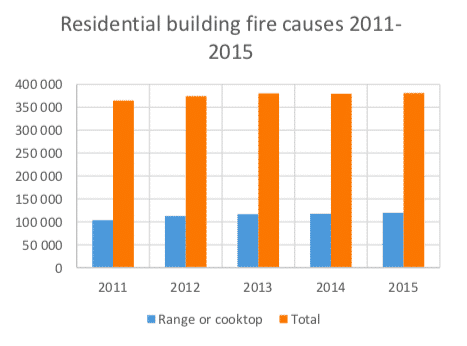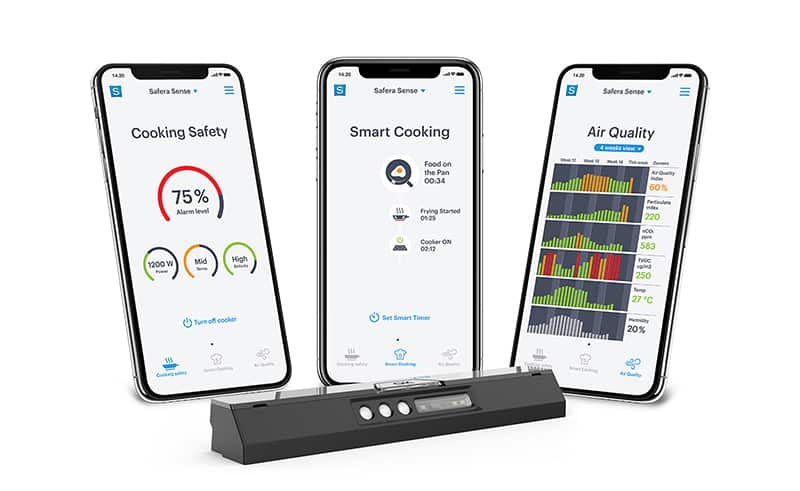Why aren't we talking about kitchen fires?
The single most common cause for dwelling house fires is a stove.
Out of the 210,000 total dwelling fires in Germany, 39% of them originated in the kitchen. In the UK, cooking is the ignition source for nearly half of all dwelling fires attended to by firefighters.
Around one-third of all household fires are caused by cooking. In fact, cooking is the largest category of dwelling fires throughout the Western world. This results to damage, property loss, injuries, and death on an annual basis.
Statistics from Around the World


From 2011-2015, an average of 30.3% of fires had originated from range or cooktop in the USA. Although 60% of cookers were electric, four out of five (79%) of the reported fires were powered by electricity. In these cases, the risk is 2.5 times higher. All cooking equipment combined had caused an even larger share (48,9%), resulting in 510 civilian fire deaths, 5,470 civilian fire injuries, and $1.2 billion in direct property damages each year.


The Safera stove guard – a natural choice
Regardless of the country’s population size, the numbers are similar across the board. In Sweden, fires are categorized by “start objects”. Cooking had accounted for 1,360 of the total 5,415 dwelling fires (25,3%) in 2015. In fact, in smaller housing categories, the share was significantly higher – up to 67% in Swedish apartment blocks. Data from Sweden shows that in these apartment buildings (also known as flerbostadshus), cooking is by far the most common cause of fires.
The issue has not been discussed as much as it should have been. Instead, the headlines often favor publishing about seasonal fire hazards and open fire related hazards. For example, in Finland there are big campaigns about the dangers of burning candles around Christmas time. However, even during the holidays, candle related fires cover a small portion of the damage compared to the damage caused by stoves. Sure, everyone is working for a good cause, but there should be more focus on stove-related fires, as well as ways to prevent them.
Preventing kitchen fires
There are several ways to reduce cooking fires. You can either
- try to avoid risky situations by being more careful,
- be prepared to limit the damage when it occurs, or
- prevent the fire with smart technology
There are plenty of smart tools for extinguishing house fires, such as: fire blankets, foam, dry powder, and fire extinguishers. They are relatively inexpensive and easy to use. Even though they can be effective in putting out the majority of small dwelling fires, they always require a human to use them. These tools are only used in the exact situation that they are needed. Unfortunately, there is the chance that It may already be too late. Alternatively, automated sprinklers can be used as a fire prevention tool, as they do not require a human to turn them on. However, they activate only after the flames have already caused damage.
Keeping the kitchen clean and tidy can also prevent cooking fires. Grease and flammable liquids can build up over time, and should be cleaned from kitchen surfaces. Buildups can easily ignite when cooking, which is why grease is one of the most common sources of ignition. Other flammable objects should be stored away from the cooktop as well.
Still, these things do not actually prevent stove fires from human errors, such as leaving the stove unattended. The best way to eliminate this is to turn the power off before the stove is dangerously hot, where the temperature becomes close to setting something on fire. Safera Sense Smart Cooking Sensor does just that, and is automatic.


Every stove needs a Stove Guard
The smart cooking sensor or more traditional Stove Guard is the most effective solution to prevent cooking fires. Safera Sense smart cooking sensor senses danger in advance, and cuts off the cooker power before a fire can ignite. It is available either pre-installed in the extractor hood, or as a product to be installed separately. Not only does it provide security, it is also a cost-effective solution for every room that has a cooktop. In addition to Safera’s well established Stove Guards, the smart cooking sensor also measures air quality and helps the user with cooking time management, which both add safety and comfort to the kitchen.
Safera Sense smart cooking sensor can help to eliminate cooking fires- the number one cause of home fires. Safera’s mission is to ensure that no more lives shall be lost to cooking fires, and to make sure that people of all ages can enjoy safe cooking at all points of their life, by sensing hazards that people cannot.
The Norwegian way is working
National safety officials in the Nordic countries are addressing the cooking fire problem by promoting the use of stove guards, with national amendments to IEC 60364 based standards.
In Norway, EN 50615 standard based stove guards became mandatory in all new dwellings in 2010. The number of cooking fires has decreased dramatically since the new regulation took effect.
EN 50615 is a standard set by CENELEC. It is the requirements for devices for fire prevention and suppression for electric hobs. Stove guards that meet the standard typically consist of a sensor unit, as well as a power control unit.
The Safera Sense Smart Cooking Sensor meets the requirements of EN 50615 if the Sensor Unit is supplemented with a Safera power control unit.
Sources:
IFS Institut für Schadenverhütung und Schadenforschung GDV Die deutsche Versicherungswirtschaf
Home Office, National statistics, Detailed analysis of fires attended by fire and rescue services, England, April 2016 to March 2017.
NFPA Research: Home structure fires involving cooking equipment, Marty Ahrens, November 2017
Emergency Services College: Finnish Rescue Services pocket statistics 2010-2014, 2011-2015 & 2012-2016
MSB – Swedish Civil Contingencies Agency: Räddningstjänst i siffror 2014, 2015 DSB Norge
See also:
FlowHero helped our customer win the Energy Genius of the Year award
Real estate investor Areim has won the prestigious Energy Genius of the Year 2024 award by successfully halving the energy consumption of ventilation in its
FlowHero Case Study: Mandatum Niittytaival 13
In Mandatum’s office building, the kitchen ventilation was a compromise between energy efficiency and indoor air quality. It was upgraded to FlowHero’s demand control ventilation,
